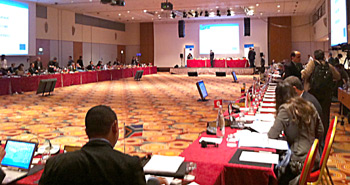ICCAT Opens in Paris, Battle Lines Drawn
by Fishermen’s Voice Staff

November 17, Paris, France, ICCAT meeting room. The multi-billion dollar tuna industry is again focused on the tug of war between business as usual groups and industry conservation groups. Seining and farming practices in the Mediterranean, critics say, must change if blurfin tuna is to survive. Chris Weiner Photo
The outstanding bluefin tuna season in the Gulf of Maine is being brought as evidence to the annual meeting of the International Committee for the Conservation of Atlantic Tuna, which this year is held in Paris, November 17-27.
Rich Ruais, Executive Director, ABFT Association, said the presence of bluefin giants, and others in numbers not seen in decades is a result of decades of conservation efforts in the United States, and the recent European restrictions on the tuna harvest in the Eastern Atlantic.
Ruais cited science that supported higher quota on both sides of the Atlantic. The western Atlantic could have, he said, have had a 2,800-Metric Ton (MT) quota, however it has been 1800 MT. In the eastern Atlantic the quota has been recently dropped from 61,000 MT to 15,000 MT.
“The result,” said Ruais, “is that a lot of tuna has been left in the water.” Some of these highly migratory tuna made their way into the western Atlantic contributing to the relative boom on Georges Bank, Cape Cod Bay, and elsewhere in the Gulf of Maine. Cape Cod Bay saw their share of 700 and 900 pound blue fin.
Competition for these tuna was high. The western Atlantic is fished by the United States, Canada, Japan, Mexico and Bermuda.
There is hope for an increase in U.S. quota based on the restoration of the western Atlantic resource, which is in no small part, the result of U.S. conservation efforts, said Ruais. At the ICCAT meeting the U.S. is seeking a modest increase in the quota from 1,800 MT to 2,250 MT. “The eastern Atlantic needs to stay at 13,500 MT,” said Ruais.
“The European community is now serious about a rebuilding plan,” said Ruais. For years the Europeans – Spain, Italy, France and others – have refused to address the declining bluefin stocks. However, pressure from a more informed public, environmental groups and international political pressure in the last few years have contributed to the changed eastern Atlantic posture.
Another factor is their bottomline. In 2004 the Europeans were taking 50,000 metric ton catches of bluefin. This was a $ billion a year industry. But catches have plunged so low that the most ardent deniers and refusniks among them have had to acknowledge the writing on the wall of this gold mine.
These facts are what make Americans, who have put in place many productive bluefin fishery restrictions in the western Atlantic while the other half of the industry in Europe ignore efforts, believe serious conservation can move forward.
The fishery in the eastern Atlantic is now largely supplying grow out facilities. The tuna are caught in June during spawning season when they are in groups and easily captured. Spawning grounds near the Spanish Baeleric Islands off Barcelona have been largely depleted. More tuna a re taken off Libya to the southeast.
Seiners net them, call in a tug boat that brings a metal tow cage to transport them to growout locations or ”farms”. The tuna are fed during the 2 day wait for the tug.
When the tug arrives, divers attach a mesh transfer tunnel to the seine. The metal cage is deployed by the tug and divers attach another mesh tunnel to the cage. The ends of the two tunnels are then attached to each other. A hatch into the cage is opened first, and then a hatch in the seine is opened to let the tuna escape into the cage. At times a motorized device needs to be used in the seine to herd straggling tuna into the cage.
From this point the tuna in the cage will be transported for from 2 weeks to 45 days. Some will go to the western Mediterranean others on a 45 day trip, at 1 to 2 knots, to Turkey. The tug stops once a day to feed the tuna, check their health and remove any dead fish.
When they arrive the tuna will be fed for 3 to 9 months. Ruais said these fish fatten quickly.
They are accustomed to expending a lot of energy to get their food. In the pens they have the food dumped on them from above. The companies raising wild tuna this way have a known quantity available, and can also wait for the Japanese market prices that usually start moving in October.
According to Ruais restrictions on tuna “farming” practices in the eastern Atlantic bluefin fishery are essential for restoring the stocks on both side of the Atlantic.
